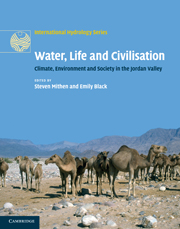Book contents
- Frontmatter
- Contents
- List of figures
- List of tables
- List of contributors
- Acknowledgements
- 1 Introduction: an interdisciplinary approach to Water, Life and Civilisation
- Part I Past, present and future climate
- Part II The palaeoenvironmental record
- 6 A review of palaeoclimates and palaeoenvironments in the Levant and Eastern Mediterranean from 25,000 to 5,000 years BP: setting the environmental background for the evolution of human civilisation
- 7 Palaeoenvironments of the southern Levant 5,000 BP to present: linking the geological and archaeological records
- 8 Using proxy data, historical climate data and climate models to investigate aridification during the Holocene
- 9 Palaeoenvironmental and limnological reconstruction of Lake Lisan and the Dead Sea
- Part III Hydrological studies of the Jordan Valley
- Part IV Human settlement, climate change, hydrology and water management
- Part V Palaeoeconomies and developing archaeological methodologies
- Part VI Society, economy and water today
- Part VII Conclusions
- Index
- Plate section
- References
8 - Using proxy data, historical climate data and climate models to investigate aridification during the Holocene
from Part II - The palaeoenvironmental record
Published online by Cambridge University Press: 26 April 2011
- Frontmatter
- Contents
- List of figures
- List of tables
- List of contributors
- Acknowledgements
- 1 Introduction: an interdisciplinary approach to Water, Life and Civilisation
- Part I Past, present and future climate
- Part II The palaeoenvironmental record
- 6 A review of palaeoclimates and palaeoenvironments in the Levant and Eastern Mediterranean from 25,000 to 5,000 years BP: setting the environmental background for the evolution of human civilisation
- 7 Palaeoenvironments of the southern Levant 5,000 BP to present: linking the geological and archaeological records
- 8 Using proxy data, historical climate data and climate models to investigate aridification during the Holocene
- 9 Palaeoenvironmental and limnological reconstruction of Lake Lisan and the Dead Sea
- Part III Hydrological studies of the Jordan Valley
- Part IV Human settlement, climate change, hydrology and water management
- Part V Palaeoeconomies and developing archaeological methodologies
- Part VI Society, economy and water today
- Part VII Conclusions
- Index
- Plate section
- References
Summary
ABSTRACT
When used in conjunction, climate models and palaeoenvironmental data can lead to a more complete understanding of past climate than is possible using either method in isolation. Moreover, the veracity of climate models can be evaluated, which then lends credence to their use for predicting future climate change. In this study we investigate the transition to aridity in the eastern Mediterranean that occurred in the Holocene, a transition with marked consequences for settlement of the Middle East. We show that the general pattern of a transition during the Holocene to a wetter northern Europe and a drier Middle East is seen in both the palaeoenvironmental record and climate model simulations. The pattern of precipitation changes projected by the climate model for the past is similar to those projected for the end of the twenty-first century under GHG-driven climate change. The climate model's ability to represent the past – as tested against palaeoenvironmental observations – thus lends credence to the future projections.
INTRODUCTION
The Holocene climate of the Middle East can be investigated using climate proxies and geological evidence (Chapters 6 and 7, this volume) or through climate modelling (Chapter 3). In this chapter, we show how combining these two approaches has the potential to deepen our understanding of the past climate. We also describe how comparison between the climate model output, proxy data and historical observations provides a means of evaluating the climate models and assessing the credibility of future projections.
Information
- Type
- Chapter
- Information
- Water, Life and CivilisationClimate, Environment and Society in the Jordan Valley, pp. 105 - 112Publisher: Cambridge University PressPrint publication year: 2011
References
Accessibility standard: Unknown
Why this information is here
This section outlines the accessibility features of this content - including support for screen readers, full keyboard navigation and high-contrast display options. This may not be relevant for you.Accessibility Information
- 2
- Cited by
